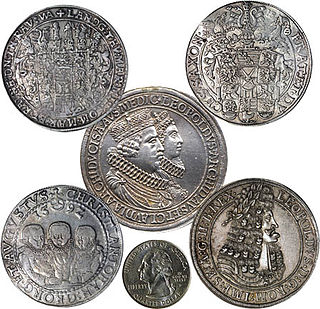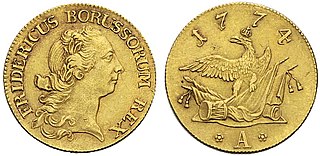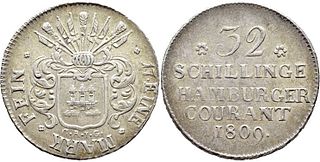Related Research Articles

A thaler or taler is one of the large silver coins minted in the states and territories of the Holy Roman Empire and the Habsburg monarchy during the Early Modern period. A thaler size silver coin has a diameter of about 40 mm and a weight of about 25 to 30 grams. The word is shortened from Joachimsthaler, the original thaler coin minted in Joachimsthal, Bohemia, from 1520.

The Swiss franc is the currency and legal tender of Switzerland and Liechtenstein. It is also legal tender in the Italian exclave of Campione d'Italia which is surrounded by Swiss territory. The Swiss National Bank (SNB) issues banknotes and the federal mint Swissmint issues coins.

The German mark was the currency of the German Empire, which spanned from 1871 to 1918. The mark was paired with the minor unit of the pfennig (₰); 100 pfennigs were equivalent to 1 mark. The mark was on the gold standard from 1871 to 1914, but like most nations during World War I, the German Empire removed the gold backing in August 1914, and gold coins ceased to circulate.

The Kreuzer, in English also spelled kreutzer, was a coin and unit of currency in the southern German states prior to the introduction of the German gold mark in 1871–1873, and in Austria and Switzerland. After 1760 it was made of copper. In south Germany the kreuzer was typically worth 4 pfennigs and there were 60 kreuzers to a gulden. Kreuzer was abbreviated as Kr, kr, K or Xr.

The Vereinsthaler was a standard silver coin used in most German states and the Austrian Empire in the years before German unification.

The Conventionstaler or Konventionstaler, was a standard silver coin in the Austrian Empire and the southern German states of the Holy Roman Empire from the mid-18th to early 19th-centuries. Its most famous example is the Maria Theresa thaler which is still minted today. The Conventionsgulden was equivalent to a 1⁄2Conventionsthaler.

The Reichsthaler, or more specifically the Reichsthaler specie, was a standard thaler silver coin introduced by the Holy Roman Empire in 1566 for use in all German states, minted in various versions for the next 300 years, and containing 25–26 grams fine silver.

The Austro-Hungarian gulden was the currency of the lands of the House of Habsburg between 1754 and 1892, when it was replaced by the Austro-Hungarian krone as part of the introduction of the gold standard. In Austria, the gulden was initially divided into 60 kreuzers. The currency was decimalized in 1857, using the same names for the unit and subunit.
The South German Gulden was the currency of the states of Southern Germany between 1754 and 1873. These states included Bavaria, Baden, Württemberg, Frankfurt and Hohenzollern. It was divided into 60 kreuzer, with each kreuzer worth 4 pfennig or 8 heller.

The Thaler was the currency of the Free Hanseatic City of Bremen until 1873, when Germany adopted the gold mark (ℳ). It was divided into 72 Grote, each of 5 Schwaren. While initially identical to the North German thaler before the 1750s, it was the only currency to maintain the gold standard of 5 thalers to a Friedrich d'or pistole from the 1750s until 1873, long after all other states adopted the Conventionsthaler.

The Hamburg Mark refers to two distinct currencies issued in the city of Hamburg until 1875:

The Kronenthaler was a silver coin first issued in 1755 in the Austrian Netherlands and which became a popular trade coin in early 19th century Europe. Most examples show the bust of the Austrian ruler on the obverse and three or four crowns on the reverse, hence the name which means "crown thaler" (also Brabanter and crocione.
The Prussian Thaler was the currency of Prussia until 1857. In 1750, Johann Philipp Graumann implemented the Graumannscher Fuß with 14 thalers issued to a Cologne Mark of fine silver, or 16.704 g per thaler.

Bavaria used the South German gulden as its currency until 1873. Between 1754 and 1837 it was a unit of account, worth 5⁄12 of a Conventionsthaler, used to denominate banknotes but not issued as a coin. The Gulden was worth 50 Conventionskreuzer or 60 Kreuzer Landmünze.

Baden used the South German gulden as its currency from 1754 until 1873. Until 1821, the Gulden was a unit of account, worth 5⁄12 of a Conventionsthaler, used to denominate banknotes but not issued as a coin. It was subdivided into 50 Conventionskreuzer or 60 Kreuzer landmünze.

The Basel Thaler was a currency denomination worth 3 livres or 30 batzen used by the Swiss Canton of Basel until 1798. It was used by both the Canton and the Bishopric of Basel.
The Thaler was a currency denomination worth 2 Gulden used by St. Gallen until 1798.
The North German thaler was a currency used by several states of Northern Germany from 1690 to 1873, first under the Holy Roman Empire, then by the German Confederation. Originally equal to the Reichsthaler specie or silver coin from 1566 until the Kipper und Wipper crisis of 1618, a thaler currency unit worth less than the Reichsthaler specie was first defined in 1667 and became widely used after adoption of the Leipzig currency standard of 1690.

The history of Saxon coinage or Meissen-Saxon coinage comprises three major periods: the high medieval regional pfennig period, the late medieval pfennig period and the thaler period, which ended with the introduction of the mark in 1871/72. Rich silver deposits, which were discovered near Freiberg after the middle of the 12th century, helped Saxony to a leading position in German coinage.

A Konventionsfuß was a coinage standard established by state treaty, the convention. The first one was between Austria and a number of German states of the Holy Roman Empire in the mid-18th century. This Convention determined that 20 gulden or 10 Speziesthaler be minted from a single Cologne mark of fine silver. Since the Cologne mark weighed approximately 233 g, one gulden had a fine weight of 11.69 g of silver.
References
- ↑ Shaw, William Arthur (1896). The History of Currency, 1252-1894: Being an Account of the Gold and Silver Moneys and Monetary Standards of Europe and America, Together with an Examination of the Effects of Currency and Exchange Phenonmena on Commercial and National Progress and Well-being (3rd ed.). New York: J. G. Putnam.
